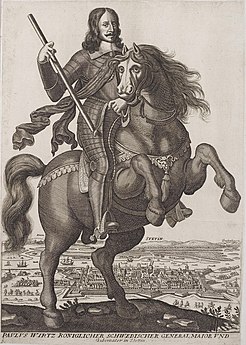Paul Würtz

Paul Würtz (also Würz or Wirtz) (October 30, 1612 - March 23, 1676) was a German officer and diplomat, who at various times was in German, Swedish, Danish, and Dutch service.
Life
He was born in Husum, Dithmarschen.
During his tenure as governor of Cracow, during Swedish-Transilvanian occupation of the city between 1655–1657, he is renowned for looting and destruction of many priceless works of art, including silver sarcophagus of Saint Stanislaus dating to 1630 and silver altar created in 1512, both from the Wawel Cathedral.[1]
He was a Swedish Pomeranian general major and commander of the Stettin fortress from 1657 to 1659. He successfully withstood a siege of Brandenburgian troops in 1659, in a counterattack captured their ammunition depot, and forced their withdrawal. From 1661 to 1664, he was vice governor of Swedish Pomerania.
Gallery
-
Paul Würtz on horseback against panorama of Szczecin
-
Wooden model to the silver altar of Saint Stanislaus, ca. 1512, the silver altar was destroyed in 1657
-
Design for silver sarcophagus of Saint Stanislaus, ca. 1630, the sarcophagus was destroyed in 1657
References
- ^ Kosman, Marceli (2005). "Elity polityczne Rzeczypospolitej wobec najazdu szwedzkiego 1655-1660". Wiadomości historyczne. Wydawnictwa Szkolne i Pedagogiczne. p. 323.
Dzieło grabieży kontynuował przez rok Paweł Wurtz, z którego polecenia wyrywano kute kraty żelazne, marmury, boazerie, podłogi, z katedry zabrano do przetopienia srebrną trumnę św. Stanisława, posągi, lichtarze, z Kaplicy Jagiellońskiej.
Sources
Werner Buchholz, Pommern, Siedler, 1999, pp. 274,276, ISBN 3-88680-272-8



